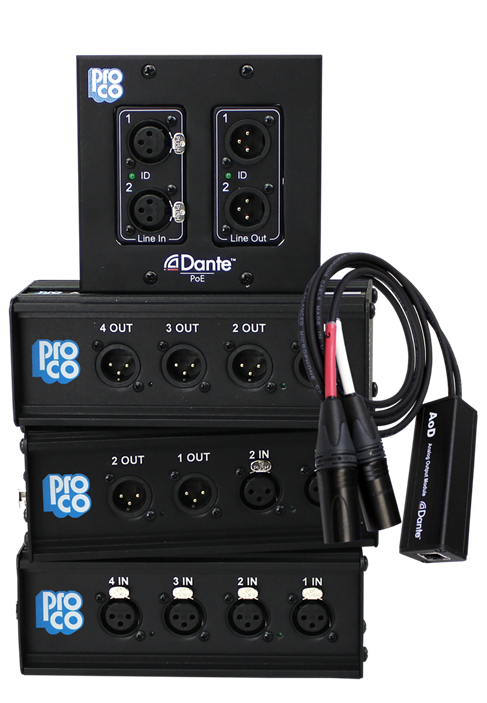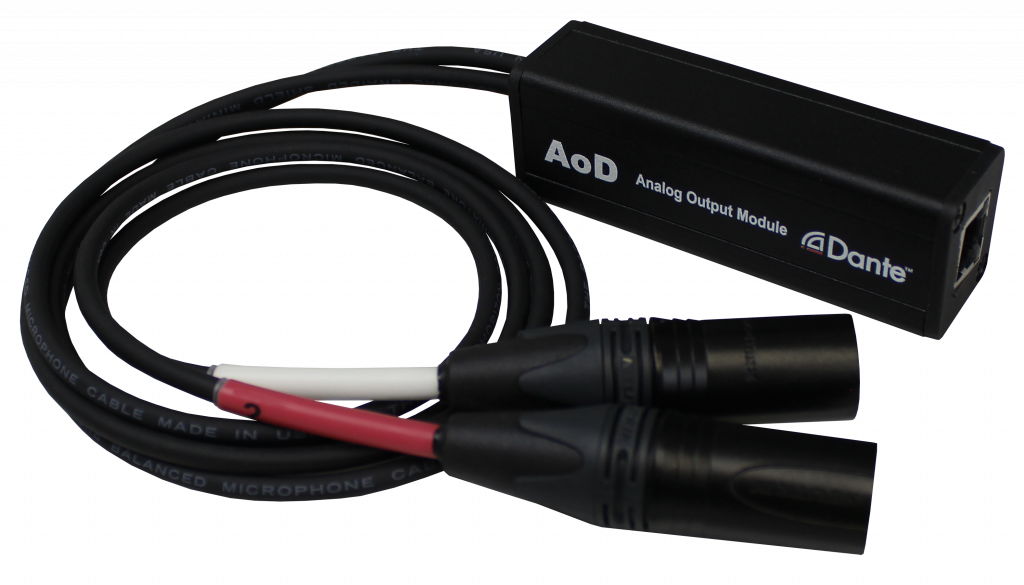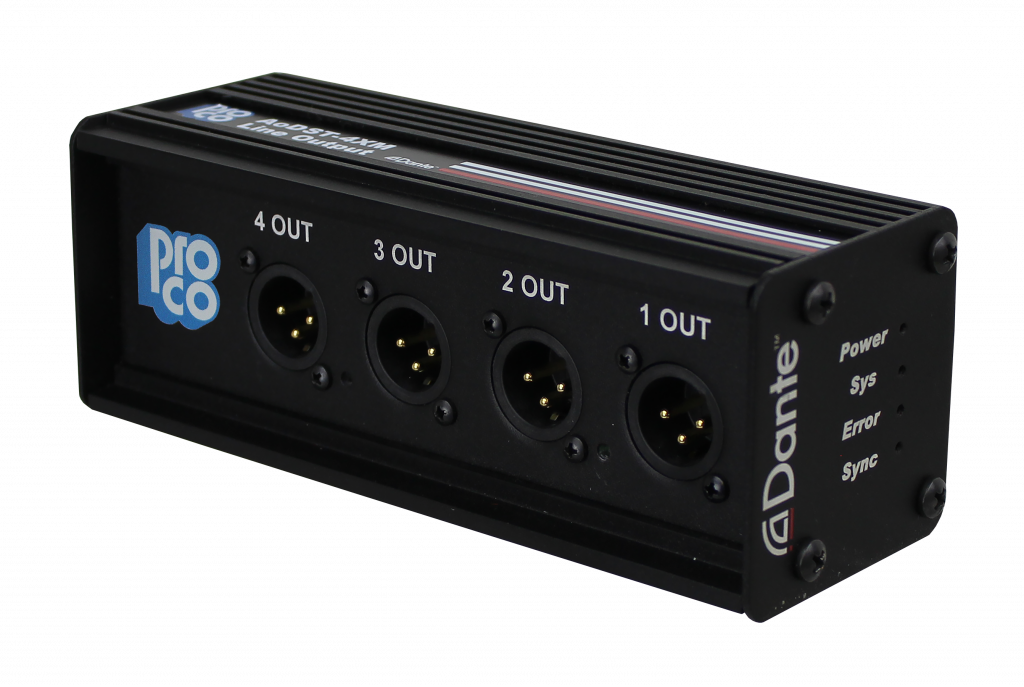


By Shawn Wells
Audinate’s Dante audio system has transformed AV connectivity in exceptional ways, but did you know that the uncompressed, multi-channel, low-latency digital audio networking technology has actually been available for nearly two decades? While it started off as a fledgling brand, a quick look at the Audinate website will tell you that Dante networking has been licensed for use in more than 3,500 products — ranging from highly technical corporate IT infrastructures and installations at amusement parks to simple setups at small theaters and houses of worship. Included among the licensees is ACT Entertainment’s ProCo Sound, which offers a series of AES67-compatible products that integrate Audinate’s latest Dante firmware.
What is Dante?
Dante literally stands for Digital Audio Networking Through Ethernet, so it goes without saying that networking is the technology’s best feature. What the acronym really means, of course, is that Dante-compatible devices and equipment can be connected using on-premises Category cables (CAT5e, CAT6) or Ethernet infrastructure, which allows integrators and installers to use a facility’s existing network. In today’s world, it’s rare to find a building that doesn’t already have internet access points — so integrating Dante technology will most often be straightforward. However, if no previous system is in place, only a limited number of cable runs and types are required, which means the installation time and cost will both still be greatly reduced when compared to other solutions.
Regardless of the approach, integrating a Dante system makes it possible for a facility to get up and running quickly, with almost no downtime — something that is increasingly critical in our evolving media landscape. Dante audio systems are also easier to expand upon, which provides an incredible level of futureproofing for facilities. This is especially useful for venues like churches, which operate with limited budgets and often need to integrate new technology over a longer window of time.
Integrating a Dante system makes it possible for a facility to get up and
running quickly, with almost no downtime — something that is increasingly
critical in our evolving media landscape.
How Does Dante Work?
Dante takes digital audio signals and segments them into packets that are suitable (aka small enough) for transmission across a standard IP (internet protocol) network. When a Dante device receives these packets, it quickly reconstructs them into one continuous, completely lossless, digital audio stream, which can be played back according to application. The same can be accomplished with digital video files.
Unlike some networking solutions, which rely on hubs or routers, Dante incorporates network switches and standard CAT5e or CAT6 cables to interconnect devices. One benefit to this approach is that switches are capable of limiting transmission traffic, to ensure all devices have adequate bandwidth.
Getting Started with Dante
Installing a Dante system is a lot like setting up your home internet. There are many avenues available to houses of worship looking to add Dante-enabled technologies. Audinate and Sweetwater both offer great Dante training videos, with step-by-step instructions that call out the best practices. So, depending on the skill level of the church staff, some facilities should be able to set up the system themselves. For those who rely on outside experts, there are many AV integrators available throughout North America that specialize both in audio and house of worship installations.
For those looking to set up devices on their own, start out with creating an Audinate account and downloading the Dante Controller software. After that, connect a CAT5e or CAT6 cable to both the primary port on the device and any port on the switch — once properly connected, the software should automatically recognize the device.
After that, it will be easy to configure signal routes and other settings using the Dante Controller software, which stores all the necessary data and eliminates the need for additional computers or hardware controllers. Best of all, even if you decide to disconnect a device and move it to another location in the facility, it will immediately start working as before.
What About Wi-Fi?
You might be thinking, “since Dante works over the internet, I must be able to use it with my facility’s Wi-Fi,” and you’d be correct — sort of. While your physical Dante hardware will still need to be hardwired into the network, you can utilize the Dante Controller software on Wi-Fi enabled devices for routing control. However, this is possible only if your Wi-Fi router is connected to the same network as the Dante devices.
Unlike some networking solutions, which rely on hubs or routers, Dante incorporates network switches and standard CAT5e or CAT6 cables to interconnect devices. One benefit to this approach is that switches are capable of limiting transmission traffic, to ensure all devices have adequate bandwidth.
What Dante Solutions Does ProCo Sound Offer?
Since Dante can easily be used with existing networks, a diverse range of installations or applications will benefit from the technology. A simple plug-and-play system, like the one at the heart of the Dante devices provided by ProCo Sound, will further improve integration. Using Dante for an entire system also creates an ecosystem that can be accessed from multiple places and allows users to easily make changes to several parts of the system from one location, using the same software.
ProCo Sound has developed a series of products with AES67-compatible features using the latest firmware from Audinate. This includes Dante wall plates, stage boxes and output modules. They feature Power over Ethernet (PoE) and are compatible with any Dante ecosystem for very low latency line-level analog signals to output devices.
The ProCo AoDDP wall plates and AoDST drop boxes each provide one RJ45 Dante input and four Neutrik connectors for input or output. Using a simple Dante network connection, these AoD wall plates and stage boxes offer studio-quality, low-latency audio using basic XLR connectors. With both solutions made of rugged aluminum enclosures, the stage boxes are perfect for mobile applications while the wall plates feature a two-gang-deep J-Box for easy installations and retrofits.
Also available with one RJ45 Dante input is the AoDoM two-channel ProCo Dante Output Module, which features two Neutrik NC3MXX-B Series XLR analog outputs. This rugged aluminum solution offers three-foot analog audio tails for simple connection to any Dante network.
From sports arenas and concert tours to your neighborhood church, all Dante users benefit from the technology’s ease-of-use and installation, as well as its completely lossless fidelity. While there are many other audio-over-ethernet protocols available, Dante has quickly become the standard in AV — and it’s likely not going anywhere any time soon.
Shawn Wells currently serves as Market Manager: Pro A/V & Artist Relations for ACT Entertainment, where he has been for more than seven years. Prior to joining ACT, Wells worked in the production industry and gained valuable hands-on experience with all audio technologies, including Dante networking.





